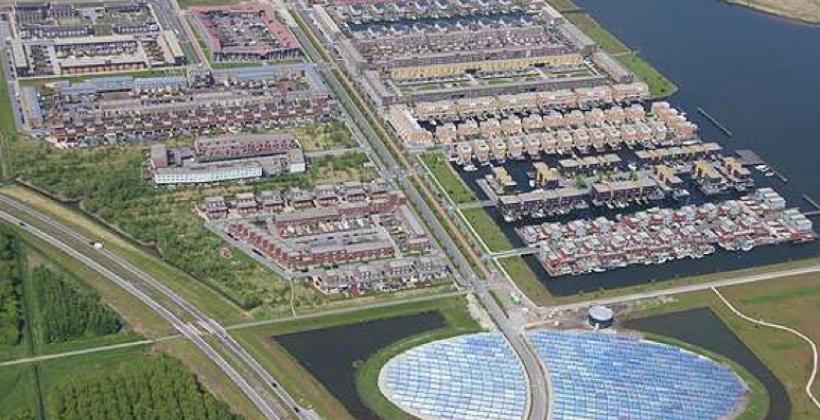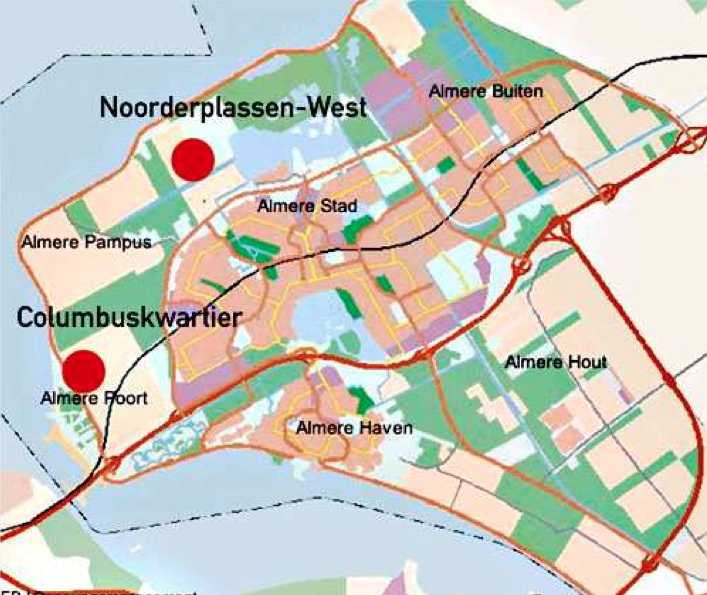
Location
Description
Almere is a young municipality. Its first house was completed only in 1976. It is sited on the reclaimed territory of Flevoland.
The Almere districts of Noorderplassen West and Columbuskwartier were thus obvious candidates for actions under the CONCERTO project. In these areas, 2,000 eco-homes are being built, along with commercial and public buildings. Specific innovations with these developments include the integration of renewable energy sources and the application of energy efficiency measures in city planning, area development, public tendering, architecture and building.
Noorderplasssen-West
Noorderplassen-West is the energy-rich district of Almere. A district brimming with energy. The sun's energy plays a main role. A solar island with solar collectors supplies warm water to nearly 3,000 homes. And schools and buildings will be equipped with solar panels. The district has approx. 550 solar homes and 600 low-energy homes. Besides the focus on solar energy, Noorderplassen-West is unique in its abundant nature and water. This new energy-rich district is surprisingly versatile for both young and old.
Columbuskwartier
Columbuskwartier will soon become another energy-rich district of Almere. Most houses will be fitted with solar panels, the so-called Solar homes. Other dwellings will also be extremely energy efficient. Besides the focus on solar energy, Columbuskwartier is child-friendly (car free) and unique in its abundant nature and water. This new energy-rich district is surprisingly versatile for both young and old.
Documents
Site facts and figures
|
Project Progess |
completed |
|
|
Noorderplassen-Wes |
||
|
Estimated population involved |
2000 |
people |
|
Approx. geographical area |
201 |
ha |
|
Land unse and type of building |
residential |
|
|
District status |
new development area |
|
|
Total heated net room area (residential) |
1000 |
m3 |
|
Total heated net room area (municipal) |
0 |
m3 |
|
Total heated net room area (tertiary) |
n/a |
m2 |
|
Total heated net room area (industrial) |
0 |
m2 |
|
CO2 emission reduction |
10 |
% |
|
Estimated amount of electricity |
||
|
Saved in CONCERTO buildings |
5 |
% |
|
Generated from RES |
n/a |
% |
|
Estimated amount of heating energy |
||
|
Saved in CONCERT buildings |
40 |
% |
|
Generated from RES |
12 |
% |
Technologies
Technologymix
In Almere CONCERTO the activities comprise the “Noorderplassen West” and the “Columbuskwartier” areas (Map 1). In both areas in total 1,710 eco-homes have been built, along with commercial and public buildings. 589 of the new dwellings are certified as “Solar Homes”, constructed from wood, with low energy demand, an optimized use of daylight and solar powered energy supply from solar panels. About 100 passive houses are planned. Heat is supplied to all the new dwellings by the means of district heating.
The district heating network in Columbuskwartier receives its heat from an existing CHP plant in Diemen across the lake between Almere and Amsterdam. Heat in Diemen is recovered from the hot exhaust gases and transported to Almere. This solution replaced the original idea of a local biomass CHP that would produce renewable heat and renewable electricity. The heat recovery covers the expected amount of renewable heat. The renewable electricity, planned to be produced by the local biomass CHP, is covered by green certificates for the same amount of electricity.
In Noorderplassen West, the city district heating delivers heat from a gas-fired CHP in Almere (Picture 2). The Solar Island (Picture 4, see “more detailed” section) near Noorderplassen West supplies renewable heat to the city district heating. The renewable heat of the Solar Island covers mainly domestic hot water and also compensates for distribution losses that otherwise would demand fossil energy.
At “Noorderplassen-West” a school complex and a health centre were built. At “Columbuskwartier” (Picture 3) most solar homes are fitted with at least 10 m² of photovoltaic. Therefore in total about 5,000 m² of small-scale photovoltaic systems are installed, summing up to more than 650 kWpeak. One zero energy single family building (TBI) with an air-to-air heat pump and PV serves as a demonstration building. The district is car-free and therefore child-friendly. Columbuskwartier will have a so-called 'child's path' with a safe pedestrian and bicycle route to school. Cars are no longer needed for transport to and from school. In many areas up to 50% of the homes may be used for business. An inner-city business park offers opportunities for small-scale light commercial activity. Thus transport needs are reduced and energy use is lowered.
Solar Island
At the new district „Noorderplassen-West“ the so-called „Solar Island“, a large field of 520 coupled solar thermal collectors, has been built. It is a unique project for Almere and even for the Netherlands. 7,135 square meters of solar thermal collectors (Picture 4 + 5) will convert solar radiation into hot water. This will supply heating energy for 2,700 homes via the district-heating grid. The “Solar Island” will supply 10% of the total heating demand; a nearby power plant will provide the remaining 90%. The, otherwise unused, waste heat from this power plant will ensure residents' heating and hot water, when the sun does not shine. The Almere “Solar Island”, combined with the CHP plant and the district-heating network, cuts CO2-emissions by 50 %. With its large collector surface the Almere “Solar Island” is the fourth largest solar collector field in the world.
The solar collectors in the Solar Island heat the water to approximately 90 °C. The heated water is transferred to the heat exchange unit. The heat energy is delivered to the heat supply grid and the cooled water is returned back to the solar collectors. The heat energy produced by the Solar Island is supplied to Noorderplassen West and to the city of Almere. Temperature and flow rate of water are metered at several points through the network.
The flow of energy in Solar Island was metered from May 2010 to June 2011 in two ways:
- detailed (based on control-sensors of the system) and
- monthly (based on the measured heat delivered to the primary grid).
The Solar Island produces 1.18-1.25 GJ/m², which is comparable with individual solar collectors. The virtual unlimited storage capability of the district heating network, allowing more transfer of solar energy, is countered by the necessity to raise the temperature first to 70oC in the solar collector before it can contribute to the district heating, which operates at a return temperature of 65oC.
The results indicate that the Solar Island converts annually 32% of the energy received as solar irradiation to heat. In each month during the monitoring for certain period abundant renewable energy, e.g. not needed in Noorderplassen West, was transferred to the rest of the city of Almere. Each month there were also periods when renewable energy was not sufficient to cover heat demand in Noorderplassen West, thus extra energy was supplied from the larger district heating system of Almere. In average, roughly 60 % of the generated heat is provided to Almere and 40 % to Noorderplassen West.

Map 1 - Location of the CONCERTO areas Noorderplassen-West and Columbuskwartier
Lessons learnt
The following information has been gathered as part of the CONCERTO Premium policy research.
Benefits of CONCERTO:
Key benefits:
Inhabitants of the cRRescendo districts display behaviour that is more sustainable than they themselves think. For instance, use of low-energy lighting, choosing low-energy domestic appliances and other RUE measures are perceived as “business as usual”.
Barriers encountered:
Administrative barriers:
When the project was submitted in 2005 there was a strong political support. In 2006 the government changed, and the new politicians had to be convinced of the value of the project
Success factors identified:
Social Success factors:
The cRRescendo project contributed to providing energy advisors for training activities addressed to private contractors that built the 10% of buildings in Noorderplassen West and Columbuskwartier.
A Programme for schools was set up including seminars for and surveys by pupils to describe their family’s behaviour regarding energy consumption and Renewable energy sources.
In Almere a big event was organised for the inauguration of the solar island. The opening was broadcasted in several TV shows.
Market actors needed to translate the cRRescendo ‘message’ into simple, local concepts. That is why the two cRRescendo districts have been branded EnergyRich Districts (Energierijke Wijken).
Accessibility of sustainability and RUE/RES advice should be improved for (potential) private investors. The training by Almere of building advisors is a good first step. This training was made possible by the cRRescendo project. Communication can be improved between the various municipal departments to increase the use of RUE/RES measures by private investors and other home buyers.
Institutional success factors:
The Almere Sustainability Lab, an innovative motor that helps to transfer sustainable policies into the building practice. It formed a network of governments, experts, businesses and citizens. The Sustainability Lab contributed to construction projects and urban planning, transferring the lessons learned from CONCERTO and other initiatives to other areas.
Taking part gives gave certain standing to the municipality, the EU-brand helped to sustain the project thruogh difficult periods.
Economic success factors:
Money was an important factor – getting EC money.
For developers this played a lesser role, as subsidy was paid in arrears, only after report to commission (hand-over certs) (quality assurance). It worked as initial incentive, but not in the end.
Some reduction in ground price for developers – all CONCERTO land was publicly owned, solar island land was given for free to energy company
Legacy – follow-on projects:
In the Almere project, the presence of a “sustainable laboratory” inside the Municipality was a direct result of CONCERTO project guaranteeing a good communication between departments and a common objectives achievement.
The lessons-learnt from cRRescendo can be used in the development of future new districts. In addition to the Sustainability Lab, the municipality can apply the Almere Principles as the basis in evaluating its own Structural Vision.
The CONCERTO approach
Noorderplassen-West
The new district will contain a so-called solar island. A unique project for Almere and even for the Netherlands.7,000 m² of solar collectors on the island will convert sunlight into hot water. This will supply heating for 2,700 homes via the district heating grid. The Solar Island Almere will supply 10% of the total heating demand, a nearby power plant will supply the remaining 90%. The, otherwise unused, waste heat from this power plant will ensure residents' heating and hot water. Even when the sun doesn't shine. The Almere Solar Island combined with conventional district heating cuts CO2-emissions by 50%.
Columbuskwartier
In the new area of Columbuskwartier renewable energy and the climate face a sunny future. Residents will harness the sun's energy for personal use. Houses, schools, shops, a sports complex and a health center will distinguish themselves by their energy efficiency and use of high quality materials.
Electricity is mainly generated by more than 7.000m² of photo-voltaic panels. That amounts to 1 Megawatt of renewable energy every year or a third of the average electricity demand per household. Each Solar Home will be fitted with at least 10 m² of solar panels on the roof or facade. This underlines the energy-rich character of the district.
Thematic Field
- New Building(s)
